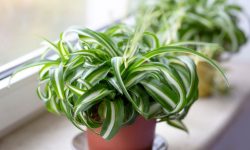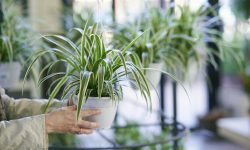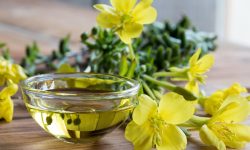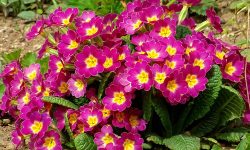Spider plants have earned their place as one of the most beloved houseplants because they grow with remarkable ease and adapt to almost any home environment. Their arching leaves create a graceful shape that brightens shelves, desks, and hanging containers. Many people enjoy them for their forgiving nature, which makes them perfect for beginners. Even with modest care, spider plants produce vibrant foliage and expressive textures that add life to indoor spaces. Their ability to create baby plantlets also brings excitement to each growing season. These plantlets allow gardeners to expand their collections naturally and share plants with friends.
Understanding how to care for spider plants helps ensure long-lasting beauty and strong year-round growth. The plant responds well to steady routines that balance light, moisture, and airflow. When gardeners learn these needs, they experience healthier leaves, stronger roots, and more frequent plantlets. Good habits prevent common problems like browning tips or wilted foliage. Spider plants reward consistent care with bright colors and full shapes that enhance any room. This guide explores each step clearly so every gardener can achieve beautiful, resilient foliage. With the right approach, spider plants become dependable companions that flourish for years.
Understanding Spider Plant Growth Patterns

Spider plants grow in graceful arches because their leaves develop from a central crown that continually produces new layers. This growth pattern gives the plant its iconic fountain shape and allows it to adapt well to different light and temperature conditions. The crown remains the heart of the plant, sending energy to both foliage and roots. When the environment stays balanced, the plant maintains a steady rhythm of leaf production. This natural cycle keeps the plant vibrant and helps gardeners anticipate how it will grow in different settings.
The plant also forms long stems that carry small plantlets, which develop when the mother plant receives enough light and nutrients. These plantlets allow the plant to reproduce easily, making spider plants ideal for beginners exploring propagation. Healthy plants often produce many plantlets at once, creating a cascading effect that enhances the plant’s decorative value. The presence of plantlets signals that the plant feels secure in its environment. Understanding this pattern helps gardeners adjust care routines to support continued production. A well-supported mother plant always generates stronger babies.
Root behavior plays a key role in overall growth. Spider plants develop thick, fleshy roots that store water and nutrients. These roots expand quickly when the potting mix drains well and the container size suits the plant’s needs. Poor drainage slows this process and causes stress that appears in the leaves. When roots feel comfortable, the plant grows fuller and more resilient. Recognizing root behavior helps gardeners decide when to repot and how to maintain soil structure. A healthy root system forms the foundation for beautiful foliage. Understanding these patterns empowers gardeners to support long-term plant health.
Providing the Right Light for Vibrant Foliage
Light plays a central role in the health of spider plants because their leaves respond directly to brightness and stability. The plant grows best in bright, indirect light where its colors remain sharp and its texture stays smooth. Direct sun can scorch the tips and fade the green tones, while low light slows leaf production. A spot near a window with filtered brightness works well for maintaining strong foliage. When the plant receives balanced light each day, its leaves arch gracefully and remain firm. Consistent lighting helps the plant express its natural shape with confidence.
Different homes offer different lighting conditions, so gardeners may need to adjust placement over time. East-facing windows provide gentle morning light that supports steady growth. North-facing windows offer softer brightness suitable for sensitive plants. If the light becomes too intense, sheer curtains help protect the leaves while still supporting photosynthesis. Signs of inadequate light include thin leaves, pale coloration, and slow development. Observing these changes helps gardeners reposition the plant before long-term health declines. A thoughtful approach to placement ensures the spider plant receives everything it needs to thrive indoors.
Artificial lighting also benefits spider plants living in dim rooms. LED grow lights set to low intensity provide enough energy for healthy photosynthesis without overheating the plant. Placing the light several inches above the foliage helps distribute brightness evenly. Gardeners should maintain a consistent schedule to imitate natural daylight patterns. This routine supports stable energy production and encourages new leaf growth. Spider plants grow predictably when their light supply stays balanced. Providing the right lighting conditions ensures rich color, strong texture, and beautiful overall form. Bright, indirect light remains the key to vibrant, long-lasting foliage.
Watering Techniques That Support Healthy Leaves
Watering affects spider plant health more than many gardeners realize because the plant responds strongly to moisture balance. Spider plants prefer soil that stays slightly moist but never soggy. Consistent overwatering removes oxygen from the root zone and causes stress that appears as browning or wilted tips. Underwatering slows growth and leads to dry, brittle leaves. The best approach is a steady routine that allows the top layer of soil to dry lightly before watering again. This pattern supports healthy roots and creates firm, vibrant foliage.
Different seasons require different watering rhythms. During warmer months, the plant uses more moisture, and the soil dries faster. Gardeners may need to check the soil more often to maintain balanced hydration. Cooler months slow evaporation, so the soil stays damp longer. Reducing the watering frequency prevents root issues and maintains lightweight soil conditions. Observing the soil texture helps gardeners determine what the plant needs. When moisture feels even and airy, the roots remain strong. A calm, consistent routine helps the plant build energy through its active growth cycle.
Water quality also influences the appearance of the leaves. Spider plants often react to minerals found in tap water, which can cause brown tips even when the watering schedule is correct. Using filtered or distilled water reduces these reactions and keeps the foliage smoother. Watering slowly allows moisture to reach the lower roots without oversaturating the soil. Some gardeners prefer bottom-watering because it encourages deeper root expansion and prevents surface buildup. With attentive watering and thoughtful adjustments, spider plants maintain lush, healthy growth. Proper moisture balance ensures long-lasting foliage and strong overall structure.
Choosing the Best Soil and Potting Mix for Strong Growth
Spider plants thrive in soil that provides both airflow and steady moisture because their roots expand quickly during active growth. A light, airy potting mix prevents the soil from becoming compacted and allows oxygen to reach the root zone. When the mix drains well, the roots stay firm and healthy, supporting fuller foliage. Soil that remains wet for too long slows development and encourages stress. A balanced blend helps the plant absorb nutrients efficiently while maintaining a stable rhythm of growth.
The structure of the potting mix also influences how well the plant adapts after repotting. Ingredients such as perlite and fine bark improve drainage and create space for new roots. Organic components help hold gentle moisture without overwhelming the plant. When the mix feels springy and loose, it supports even distribution of water throughout the pot. This consistency keeps the roots active and reduces the risk of overwatering. A well-prepared potting mix becomes the foundation of strong, long-lasting health. Gardeners often notice brighter foliage and faster growth when the soil structure remains balanced.
Spider plants also benefit from periodic soil refreshment because older soil loses nutrients over time. Replacing part of the mix every year helps restore fertility and encourages new leaf formation. Gardeners should avoid heavy garden soil because it compresses quickly and traps excess water. A simple indoor potting blend offers better results and ensures reliable drainage. After repotting, light watering helps settle the soil around the roots. This gentle start allows the plant to adjust comfortably. Thoughtful soil choices create the ideal environment for strong root development, lush foliage, and reliable long-term growth.
Understanding Temperature and Humidity Needs
Temperature stability plays a major role in maintaining strong spider plant growth because sudden changes disrupt the plant’s natural rhythm. These houseplants prefer warm indoor conditions that stay consistent throughout the day. When temperatures remain steady, the plant processes nutrients more effectively and produces smoother leaves. Cold drafts from windows or air conditioners create stress that appears as limp or pale foliage. Placing the plant away from vents helps prevent temperature shock. Warm rooms with soft lighting create the ideal backdrop for healthy development. Consistency always supports stronger, more confident growth.
Humidity also influences spider plant foliage because dry indoor air reduces moisture within the leaves. Low humidity often leads to crisp brown tips that interrupt the plant’s natural beauty. Increasing surrounding moisture helps protect the foliage and encourages fresh leaf production. Grouping plants together enhances the air’s softness and forms a supportive microclimate. Light misting can help, but it should be done carefully to avoid excess moisture on the soil. Gentle environmental humidity keeps the plant comfortable during seasonal shifts. Monitoring leaf texture helps gardeners respond quickly to subtle changes.
Airflow completes the balance by keeping the environment fresh without overwhelming the plant. Spider plants appreciate soft movement of air that prevents stagnation while preserving leaf moisture. Rooms with quiet fans or occasional open windows offer ideal airflow. Harsh drafts should be avoided because sudden bursts of air shock the plant and dry the soil too quickly. Balanced ventilation supports even hydration and reduces risks of fungal growth. When temperature, humidity, and airflow align, spider plants grow with graceful arches and vibrant color. A calm climate encourages long-lasting health and maintains the plant’s distinctive beauty.
Fertilizing Spider Plants for Strong, Lush Growth
Fertilizing spider plants supports vibrant foliage because nutrients fuel the plant’s natural growth cycle. A balanced, diluted fertilizer provides steady energy that strengthens both leaves and roots. Spider plants respond well to gentle feeding during their active seasons, especially when the soil has aged or lost nutrients. Light fertilization helps restore color and promotes fuller leaf production. Gardeners should avoid strong formulas because young or sensitive roots may react poorly. A slow, measured approach allows the plant to grow without stress. Consistent routines create dependable growth and improve overall plant health.
Soil condition affects how effectively fertilizers work. Fresh potting mix already contains nutrients, so the plant may not need immediate feeding after repotting. As months pass, these nutrients diminish, and gentle supplementation becomes beneficial. Fertilizer supports the plant’s internal structure by enhancing cell formation and improving moisture absorption. When the plant receives balanced nutrients, its leaves grow thicker and maintain brighter color. Observing how the foliage responds helps adjust the feeding schedule. A plant showing pale or slow growth may need slightly more support. Fertilization remains most effective when combined with proper watering and lighting.
Overfertilizing can create issues because excess minerals accumulate in the soil. These buildups may cause brown leaf tips or weakened root activity. Gardeners can prevent this by flushing the soil occasionally with clean water to remove lingering salts. This process keeps the root zone open and allows nutrients to distribute evenly. Spider plants thrive when feeding stays moderate and predictable. During cooler months, reduced fertilization helps the plant rest naturally. When the growth season returns, careful feeding renews energy and supports strong expansion. Thoughtful fertilization creates lush, long-lasting foliage and a healthier overall plant.
Repotting Spider Plants Without Causing Stress
Repotting spider plants supports long-term health because their roots expand quickly and eventually fill the container. When the roots become crowded, growth slows and leaves may lose their bright color. Repotting provides fresh space, new nutrients, and better airflow around the root zone. Choosing a pot only slightly larger than the current one helps maintain balanced moisture. Oversized pots stay wet for too long, which increases stress. A careful, steady approach allows the plant to adjust smoothly and continue growing with confidence.
The process begins by gently removing the plant from its old pot and examining the root system. Healthy spider plant roots appear thick and pale, with a firm texture that signals strong development. If the roots circle tightly around the pot, the plant is ready for more space. Shaking off old soil helps refresh the environment and encourages new root growth. Fresh potting mix provides better structure and improved drainage. When the plant is placed into its new container, gardeners should fill the surrounding space with light, airy soil rather than compacting it too tightly. This supports quick adaptation and reduces the risk of root damage.
After repotting, the plant needs time to settle. A light watering helps the soil wrap gently around the roots without overwhelming them. Bright, indirect light supports recovery by fueling early photosynthesis without adding heat stress. Avoiding sudden environmental changes gives the plant a calm atmosphere during its transition. The leaves may appear still for a few days, but this quiet period is normal. Once the plant adjusts, new growth appears and foliage becomes fuller and more vibrant. Repotting with care ensures a healthy foundation, long-term stability, and a beautiful, resilient spider plant.
Preventing and Treating Common Spider Plant Problems
Spider plants remain resilient, but they still face challenges when their environment becomes unbalanced. Browning leaf tips often appear when humidity drops or minerals build up in the soil. This change affects the plant’s appearance and signals a need for better moisture control. Using filtered water and adjusting humidity helps restore healthy leaf texture. Yellowing leaves may indicate inconsistent watering or low light levels. Simple adjustments usually resolve these issues quickly and support stronger, greener foliage. Observing early signs allows gardeners to act before problems worsen.
Pests occasionally affect spider plants, especially when conditions stay warm and stagnant. Common insects include spider mites, aphids, and mealybugs, which feed on leaf sap and weaken the plant over time. Regular inspection helps detect these pests early. Wiping the leaves with a damp cloth or applying a gentle insecticidal solution removes most infestations. Maintaining airflow reduces pest activity because insects thrive in still environments. Spider plants recover quickly once the pests are removed. Their strong root systems help them rebound and produce fresh, clean foliage.
Root issues also occur when the soil stays too wet for long periods. Overwatering suffocates the roots and may lead to rot, which spreads silently through the pot. Gardeners can prevent this by checking soil moisture regularly and ensuring proper drainage. If root rot appears, repotting the plant into fresh, dry soil often saves it. Trimming damaged roots helps the plant redirect energy to new growth. With steady care, spider plants overcome most challenges and return to their natural vigor. Preventing problems through observation creates a healthier environment and promotes long-lasting beauty.
Encouraging Spider Plant Babies for Fuller, More Attractive Growth
Spider plants produce babies when they feel secure, well-fed, and comfortably settled in their environment. These plantlets appear on long, graceful stems and signal strong internal energy. When the plant receives bright, indirect light and steady moisture, it begins forming buds near the tips of its stems. These buds develop into small clusters of leaves that eventually become fully shaped babies. A consistent environment encourages this natural process. Spider plants that feel supported grow with confidence and reward their owners with frequent, healthy plantlets.
Nutrient balance also influences plantlet production because spider plants use stored energy to form these offshoots. Light, regular fertilization during the active growing season strengthens the mother plant and accelerates baby formation. A well-fed plant shows richer green color and develops stronger stems capable of supporting multiple plantlets. Adequate root space further improves this process. When the plant becomes root-bound, it often slows its production. Repotting into a slightly larger container refreshes the soil and restores growth momentum. These small adjustments support steady propagation and fuller plant shape.
Environmental stability completes the conditions needed for abundant plantlets. Spider plants dislike sudden changes in temperature, humidity, or placement because these shifts interrupt their rhythm. A calm setting with gentle airflow and predictable care encourages the plant to continue producing babies throughout the year. Gardeners who monitor soil moisture, maintain soft light, and avoid harsh drafts see the best results. As plantlets grow, the overall display becomes more impressive, with cascading stems creating a layered, decorative look. Encouraging healthy babies adds beauty, vitality, and movement to the plant, turning it into a lively centerpiece for any indoor space.
Seasonal Care Tips for Year-Round Spider Plant Health
Seasonal care plays an important role in maintaining strong spider plant growth because each part of the year affects temperature, light, and moisture. During spring, the plant wakes from its slower winter rhythm and begins producing new leaves. This is the ideal time to refresh the soil, adjust watering routines, and increase light exposure. The lengthening days encourage active growth, and the plant responds quickly to consistent care. Light fertilization also helps strengthen new shoots and prepares the plant for fuller foliage.
Summer brings faster growth and higher moisture demands because warm temperatures increase evaporation. Spider plants appreciate bright rooms with filtered sunlight during this season. If exposed to direct sun for too long, the leaves may scorch, so placement becomes important. Watering should be monitored more closely because the soil dries faster. Increased humidity supports softer leaves and reduces stress. This is also the time when many spider plants begin forming plantlets, especially if they receive enough nutrients. Summer growth often appears vigorous and expressive.
Autumn and winter shift the plant’s needs because cooler temperatures slow development. Spider plants require less water during this season, and overwatering becomes a common issue. Reduced light may cause slower leaf formation, but the plant remains stable if it receives bright, indirect light. Fertilization should decrease or pause entirely because the plant rests naturally. Maintaining steady indoor warmth protects the roots from cold stress. Occasional misting helps prevent dry tips when indoor heating reduces humidity. Adjusting care through each season ensures healthy foliage, strong roots, and smooth growth throughout the year.
FAQs About Caring for Spider Plants
Why are the tips of my spider plant leaves turning brown?
Brown tips usually come from low humidity, inconsistent watering, or minerals in tap water. Spider plants react strongly to chlorine, fluoride, and salt buildup in the soil. Using filtered water and keeping the soil evenly moist helps prevent browning. Increasing humidity around the plant also improves leaf texture and reduces dryness during seasonal changes.
How often should I water my spider plant?
Spider plants prefer slightly moist soil, so watering once the top layer feels dry works best. The plant needs more water in warm seasons and less during winter. Overwatering causes root stress and wilted leaves, while underwatering leads to brittle growth. A steady routine tailored to your home’s environment keeps the plant healthy and balanced.
Does a spider plant need direct sunlight?
Spider plants grow best in bright, indirect light because direct sun can scorch their leaves. Filtered morning light works well, but harsh afternoon sun may cause fading or dry tips. If your home is dim, gentle artificial lighting keeps growth steady. Balanced light creates vibrant foliage and encourages the plant to produce healthy babies.
When should I repot my spider plant?
Repotting becomes necessary when roots begin circling the pot or push upward through the soil. A slightly larger pot provides more space and prevents overcrowding. Fresh potting mix improves drainage and renews nutrients. Spring is the best time to repot because the plant enters its active growth phase and adjusts more easily to new conditions.
How do I help my spider plant produce more babies?
Spider plants produce babies when they receive enough light, proper nutrients, and stable moisture. Mild fertilization during the growing season strengthens the mother plant and encourages offshoot formation. Avoid extreme changes in temperature or placement because stability helps the plant feel secure. With balanced care, plantlets appear naturally and grow vigorously.






